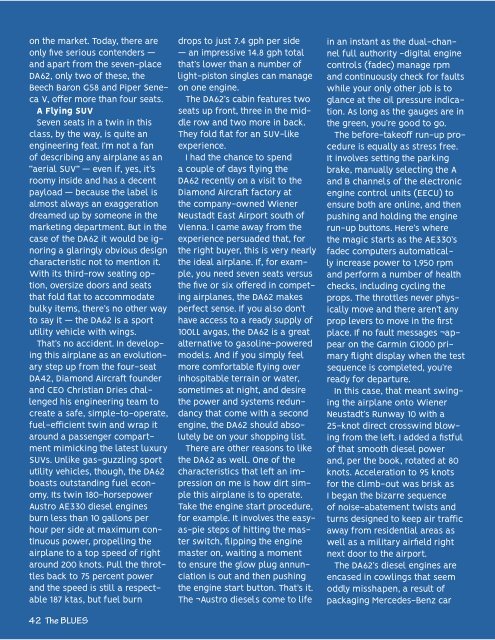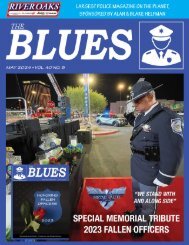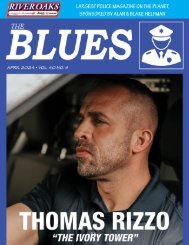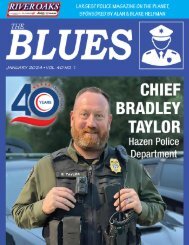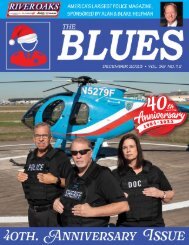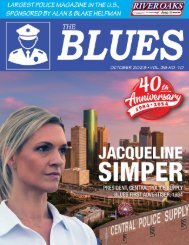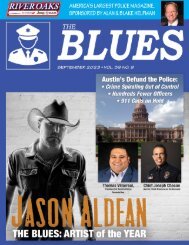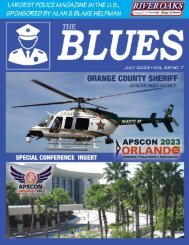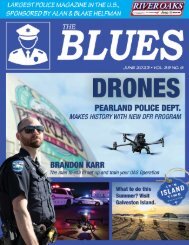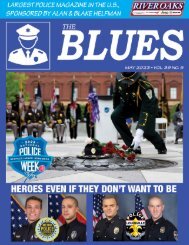JULY 2022. Blues Vol 38 No. 7
JULY 2022. Blues Vol 38 No. 7.1 FEATURES 38 COVER STORY - Diamond DA62-MPP 50 INSERT: APSCON Convention - Reno 66 12 Innovative Police Technologies 76 Sheriff’s Association of Texas Conference - Ft. Worth 84 Visit Galveston Island this Summer DEPARTMENTS 6 Publisher’s Thoughts 8 Editor’s Thoughts 10 Guest Commentary 14 News Around the US 34 Breaking News 90 Remembering Our Fallen Heroes 110 War Stories 114 Aftermath 118 Open Road 120 Healing Our Heroes 122 Daryl’s Deliberations 124 HPOU - From the President, Douglas Griffith 126 Light Bulb Award 128 Running 4 Heroes 130 Blue Mental Health with Dr. Tina Jaeckle 132 Off Duty 136 Ads Back in the Day 140 Parting Shots 142 Buyers Guide 160 Now Hiring - L.E.O. Positions Open in Texas 198 Back Page
JULY 2022. Blues Vol 38 No. 7.1
FEATURES
38 COVER STORY - Diamond DA62-MPP
50 INSERT: APSCON Convention - Reno
66 12 Innovative Police Technologies
76 Sheriff’s Association of Texas Conference - Ft. Worth
84 Visit Galveston Island this Summer
DEPARTMENTS
6 Publisher’s Thoughts
8 Editor’s Thoughts
10 Guest Commentary
14 News Around the US
34 Breaking News
90 Remembering Our Fallen Heroes
110 War Stories
114 Aftermath
118 Open Road
120 Healing Our Heroes
122 Daryl’s Deliberations
124 HPOU - From the President, Douglas Griffith
126 Light Bulb Award
128 Running 4 Heroes
130 Blue Mental Health with Dr. Tina Jaeckle
132 Off Duty
136 Ads Back in the Day
140 Parting Shots
142 Buyers Guide
160 Now Hiring - L.E.O. Positions Open in Texas
198 Back Page
You also want an ePaper? Increase the reach of your titles
YUMPU automatically turns print PDFs into web optimized ePapers that Google loves.
on the market. Today, there are<br />
only five serious contenders —<br />
and apart from the seven-place<br />
DA62, only two of these, the<br />
Beech Baron G58 and Piper Seneca<br />
V, offer more than four seats.<br />
A Flying SUV<br />
Seven seats in a twin in this<br />
class, by the way, is quite an<br />
engineering feat. I’m not a fan<br />
of describing any airplane as an<br />
“aerial SUV” — even if, yes, it’s<br />
roomy inside and has a decent<br />
payload — because the label is<br />
almost always an exaggeration<br />
dreamed up by someone in the<br />
marketing department. But in the<br />
case of the DA62 it would be ignoring<br />
a glaringly obvious design<br />
characteristic not to mention it.<br />
With its third-row seating option,<br />
oversize doors and seats<br />
that fold flat to accommodate<br />
bulky items, there’s no other way<br />
to say it — the DA62 is a sport<br />
utility vehicle with wings.<br />
That’s no accident. In developing<br />
this airplane as an evolutionary<br />
step up from the four-seat<br />
DA42, Diamond Aircraft founder<br />
and CEO Christian Dries challenged<br />
his engineering team to<br />
create a safe, simple-to-operate,<br />
fuel-efficient twin and wrap it<br />
around a passenger compartment<br />
mimicking the latest luxury<br />
SUVs. Unlike gas-guzzling sport<br />
utility vehicles, though, the DA62<br />
boasts outstanding fuel economy.<br />
Its twin 180-horsepower<br />
Austro AE330 diesel engines<br />
burn less than 10 gallons per<br />
hour per side at maximum continuous<br />
power, propelling the<br />
airplane to a top speed of right<br />
around 200 knots. Pull the throttles<br />
back to 75 percent power<br />
and the speed is still a respectable<br />
187 ktas, but fuel burn<br />
drops to just 7.4 gph per side<br />
— an impressive 14.8 gph total<br />
that’s lower than a number of<br />
light-piston singles can manage<br />
on one engine.<br />
The DA62’s cabin features two<br />
seats up front, three in the middle<br />
row and two more in back.<br />
They fold flat for an SUV-like<br />
experience.<br />
I had the chance to spend<br />
a couple of days flying the<br />
DA62 recently on a visit to the<br />
Diamond Aircraft factory at<br />
the company-owned Wiener<br />
Neustadt East Airport south of<br />
Vienna. I came away from the<br />
experience persuaded that, for<br />
the right buyer, this is very nearly<br />
the ideal airplane. If, for example,<br />
you need seven seats versus<br />
the five or six offered in competing<br />
airplanes, the DA62 makes<br />
perfect sense. If you also don’t<br />
have access to a ready supply of<br />
100LL avgas, the DA62 is a great<br />
alternative to gasoline-powered<br />
models. And if you simply feel<br />
more comfortable flying over<br />
inhospitable terrain or water,<br />
sometimes at night, and desire<br />
the power and systems redundancy<br />
that come with a second<br />
engine, the DA62 should absolutely<br />
be on your shopping list.<br />
There are other reasons to like<br />
the DA62 as well. One of the<br />
characteristics that left an impression<br />
on me is how dirt simple<br />
this airplane is to operate.<br />
Take the engine start procedure,<br />
for example. It involves the easyas-pie<br />
steps of hitting the master<br />
switch, flipping the engine<br />
master on, waiting a moment<br />
to ensure the glow plug annunciation<br />
is out and then pushing<br />
the engine start button. That’s it.<br />
The ¬Austro diesels come to life<br />
in an instant as the dual-channel<br />
full authority -digital engine<br />
controls (fadec) manage rpm<br />
and continuously check for faults<br />
while your only other job is to<br />
glance at the oil pressure indication.<br />
As long as the gauges are in<br />
the green, you’re good to go.<br />
The before-takeoff run-up procedure<br />
is equally as stress free.<br />
It involves setting the parking<br />
brake, manually selecting the A<br />
and B channels of the electronic<br />
engine control units (EECU) to<br />
ensure both are online, and then<br />
pushing and holding the engine<br />
run-up buttons. Here’s where<br />
the magic starts as the AE330’s<br />
fadec computers automatically<br />
increase power to 1,950 rpm<br />
and perform a number of health<br />
checks, including cycling the<br />
props. The throttles never physically<br />
move and there aren’t any<br />
prop levers to move in the first<br />
place. If no fault messages ¬appear<br />
on the Garmin G1000 primary<br />
flight display when the test<br />
sequence is completed, you’re<br />
ready for departure.<br />
In this case, that meant swinging<br />
the airplane onto Wiener<br />
Neustadt’s Runway 10 with a<br />
25-knot direct crosswind blowing<br />
from the left. I added a fistful<br />
of that smooth diesel power<br />
and, per the book, rotated at 80<br />
knots. Acceleration to 95 knots<br />
for the climb-out was brisk as<br />
I began the bizarre sequence<br />
of noise-abatement twists and<br />
turns designed to keep air traffic<br />
away from residential areas as<br />
well as a military airfield right<br />
next door to the airport.<br />
The DA62’s diesel engines are<br />
encased in cowlings that seem<br />
oddly misshapen, a result of<br />
packaging Mercedes-Benz car<br />
engines on an airplane.<br />
Climbing to 5,000 feet at 110<br />
kias, the DA62 maintained a<br />
1,450 fpm rate of climb at our<br />
midweight with two on board<br />
and half fuel. Accelerating to<br />
a cruise climb speed of 128<br />
kias produced a 1,200 fpm rate<br />
through 8,000 feet. That’s when<br />
I asked my host in the right seat,<br />
Diamond Aircraft director of<br />
flight operations Martin Scherrer,<br />
for a demonstration of the DA62’s<br />
¬single-engine performance.<br />
Still climbing, at his direction I<br />
flicked off the left engine master<br />
switch (the left is the critical engine<br />
in the DA62). The ¬propeller<br />
immediately stopped, automatically<br />
feathering as it did so.<br />
The airplane lurched left as a<br />
result of loss of thrust on that<br />
side, and I instinctively raised the<br />
left wing, stepped on the rudder,<br />
and then dialed in rudder trim<br />
to compensate. After that, the<br />
airplane was as easy to fly on<br />
one engine as on two. Earning a<br />
multiengine rating in a DA62 with<br />
its two power levers (opposed<br />
to the usual six levers found in<br />
most piston twins) would almost<br />
be cheating, I decided. I let the<br />
speed come back to the 87-knot<br />
blue line (single-engine best<br />
rate-of-climb airspeed) and was<br />
impressed to see us still climbing<br />
at 450 fpm.<br />
Speed Test<br />
Next I wanted to evaluate the<br />
DA62’s cruise performance to<br />
see if this really is a 200-knot<br />
airplane as Dries originally envisioned.<br />
I leveled off at 14,000<br />
feet with the throttles pushed<br />
full forward to max continuous<br />
power of 95 percent and<br />
let the speed build. On this day,<br />
slightly warmer than standard<br />
and a little lower than optimal, I<br />
managed to coax 195 ktas from<br />
those twin AE330s while burning<br />
18.6 gph. Hitting 200 knots in a<br />
Beech Baron in similar conditions<br />
would result in a fuel consumption<br />
of around 30 gph, so I<br />
wasn’t terribly disappointed with<br />
the results I was seeing.<br />
I tried out a variety of power<br />
settings and found what I<br />
considered a sweet spot at 60<br />
percent power showing 170 ktas<br />
and 11.8 gph fuel consumption.<br />
After heading lower and trying<br />
a series of steep turns and<br />
power-on and -off stalls (which<br />
were, predictably, nonevents<br />
with nothing more dramatic than<br />
a slight wing drop in the stalls),<br />
42 The BLUES The BLUES 43


